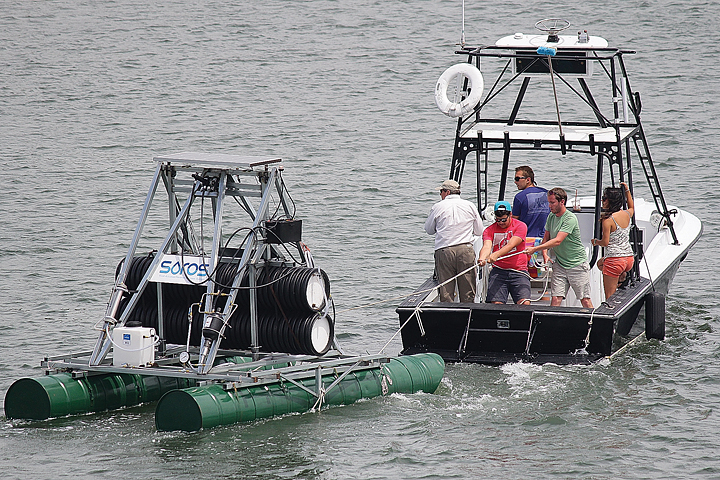Even though ocean water covers 71 percent of the Earth’s surface, as many as 1 billion people around the world lack clean water.
Scientists, politicians and advocates have grappled with the issue for years but an innovative desalination project tested off the coast of Wrightsville Beach May 14 and 15 could be a step toward the solution.
Wilmington native Donald Justin Sonnett is part of the team of engineering students who designed and built a desalination rig powered exclusively by wave energy. It began as a senior project at the University of North Carolina Charlotte, but Sonnett, Humberto Covarrubias and Chris Matthews are working after graduation to get the design in the hands of those who need it.
“It’s designed for third-world countries that have limited access to drinking water but have waves and saltwater … [where] up to 80 percent of the electricity generated goes to these big plants to run the desalination process. It’s really energy hungry. We’re trying to meet that need,” Sonnett said on May 14.
Capturing wave energy to power desalination is not a new idea, but the team’s decision to forgo electricity production and use highly pressurized water is revolutionary.
Fred Wagner, a partner at Charlotte-based business development firm Enventys who financially supports the project, said converting wave energy to electricity to high-pressure water contributes to a big energy loss.
“The ah-ha moment was going, ‘Don’t try to make electricity. Go directly for what you want,’” Wagner said on May 14.
The system is called SAROS, or Swell Actuated Reverse Osmosis System. The 15-foot-long, 2,400-pound desalination rig, which is a smaller prototype of the original design, took four months to build and cost between $10,000-$12,000.
Wagner said he was impressed with how quickly the team executed the idea.
“What was interesting about this whole thing was how fast it went together. These guys were finishing school. They did this in their spare time,” Wagner said.
A hose stretching 10 feet below the rig sucks up seawater. A large pendulum captures wave energy, pumping the water through a filter to remove sediment before running it through a reverse osmosis process, which uses a molecular filter to separate salt molecules from water. The product is both clean water and briny concentrate. Concentrate is discharged into the ocean and clean water is captured.
The first trial took place at Wrightsville Beach in March, when the team tested the pendulum to see if it could produce high enough pressure and flow rates to sustain the desalination process. The May trials were the first time the desalination process was tested. Despite light swell conditions, Sonnett said the process was successful.
“It worked. We made fresh water but not as much as we expected. … Now we need to figure out how to capitalize on smaller motions of the waves,” Sonnett said.
Sonnett reported the rig produced half as much as the 100 gallons expected. He sampled the final product to assure it was fresh, drinkable water.
“It tasted like Wrightsville Beach water. It was definitely no Dasani but it wasn’t salty,” Sonnett said.
The team will tweak the design to work better in smaller swells before returning to Wrightsville Beach to test again. Sonnett estimated it would take two or three weeks to make the changes. In the meantime, they are working to secure a sponsor.
“It’s not just a cost problem for us. … We’ve got an idea here and we know we can scale it up, but what we need is real world application. If we can find a sponsor that has access to that, things will go very quickly from that point,” Wagner said.
email [email protected]




